
I've been holding on to this 1950's tin
toy handcar for some time, waiting for an inspiration of sorts
to spur my imagination. I asked myself: "What can these two tin
men on a handcar be doing that lends itself to something fun and
interesting?"
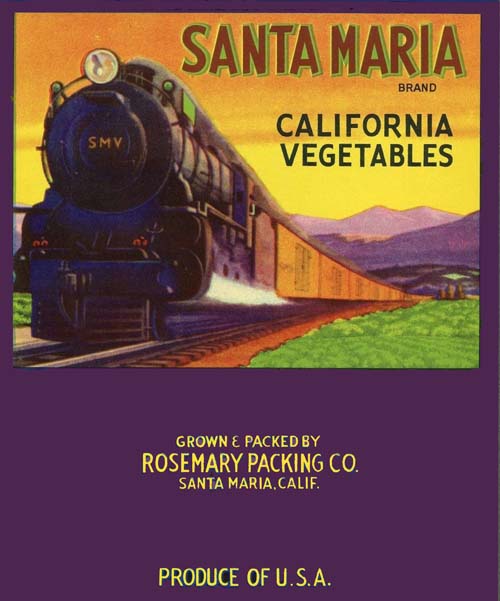
I came across this California
based crate label with a train on it and decided I could tie my
handcar gents into a railroad-vegetable experience.
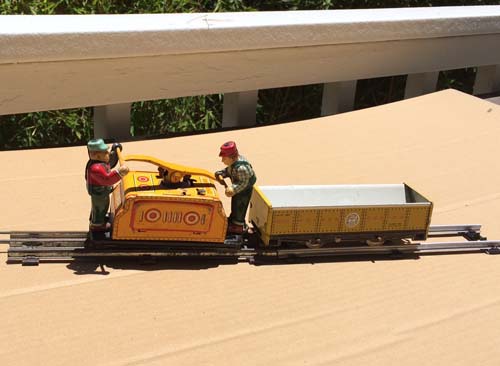
Hooking an open hopper railcar up to the
handcar and placing both on a train track was the beginning of
the story.
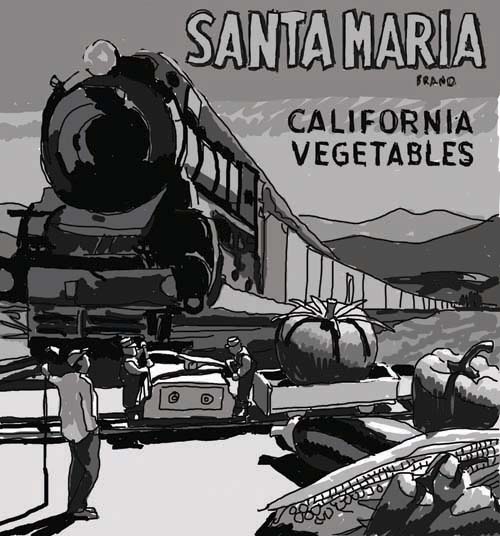
Positioning the crate label on the back wall,
providing a colorful backdrop for the train track with the
handcar, I drew in a farmer, holding a hoe, admiring the
California bounty. A tomato in the hopper railcar and a variety
of other California grown veggies compliment the design.
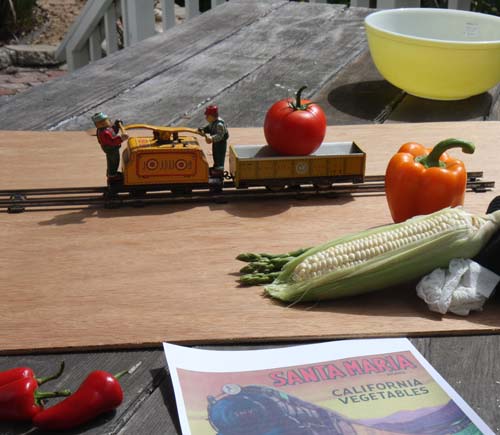
I've gathered up the vegetables, the handcar and the hopper and
have begun to assemble the elements of the painting.
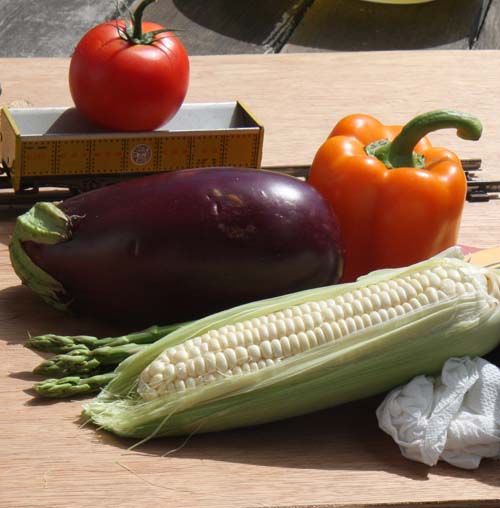
I'm trying various arrangements of the vegetables and also leave
open the option of making them larger or smaller than their
proportionate size.
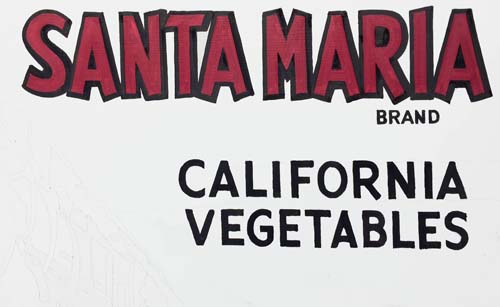
Still needing to photograph my model, and needing to see what he
looks like when I position him in the design, I've moved away
from the bottom of the painting and started painting in the
lettering on the crate label.
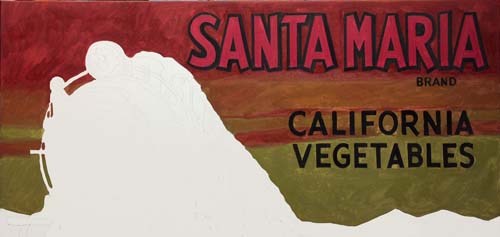
Blocking in the large background areas of sky, I purposely
grayed (darkened) the colors since they will be in the shade in
this painting.
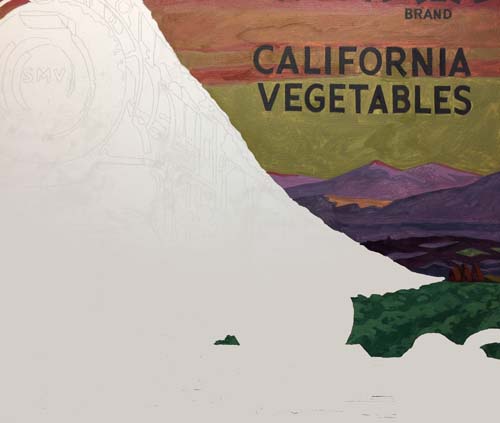
I've added the background mountains and foreground agricultural
fields of the crate label. These areas of the label are very
simplistic in design and I will try and be true to the artist's
intentions.
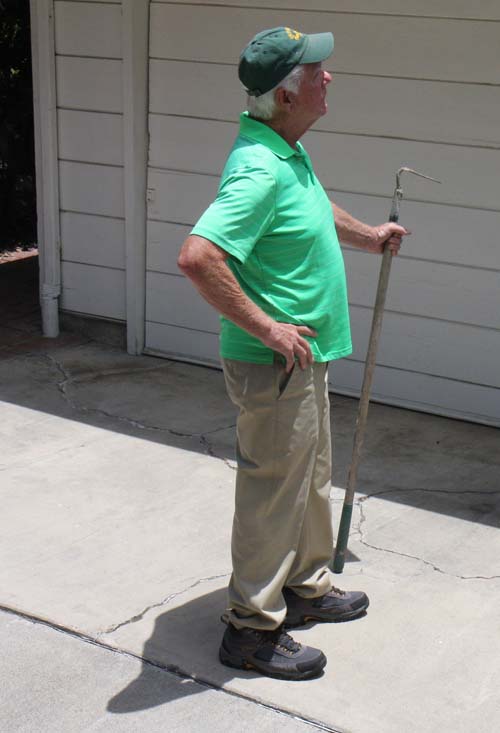
My model for "California Vegetables" is my friend and golfing
buddy, Jay. I was planning on painting in a green hue on his
hat, but since this Irishman tends to favor the emerald isle, he
supplied his own green hat. I will most likely be altering his
shirt and trouser colors in the painting, but he sure looks good
in that green shirt! Thanks Jay for the great pose (and
conversation).
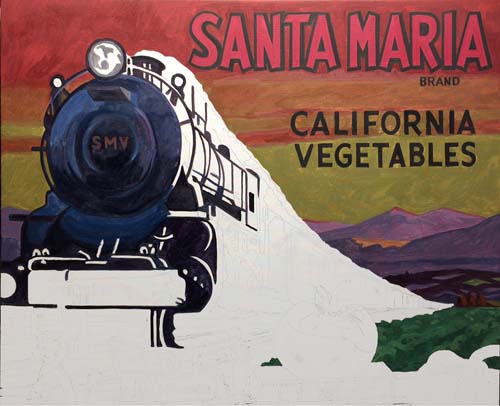
With the background of the crate label blocked in, I'm now
moving on to the train. The front of the train contains a few
very dark values, making the crate label dramatic. I've mixed
thalo blue and black, along with some alizaron crimson to make
up the various dark hues.
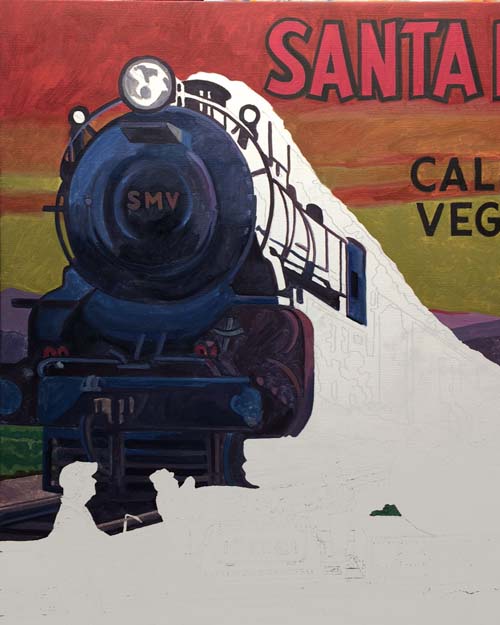
Chuggin' along on the train...very dark values.
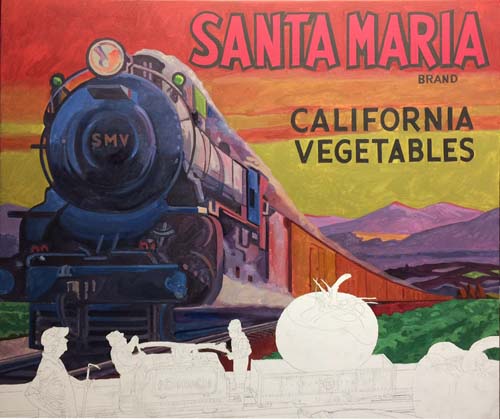
The background is completely filled in with its first coat of
turpentine thinned oil. I am sure that I will be making many
adjustments in value and color after the foreground is painted
in.
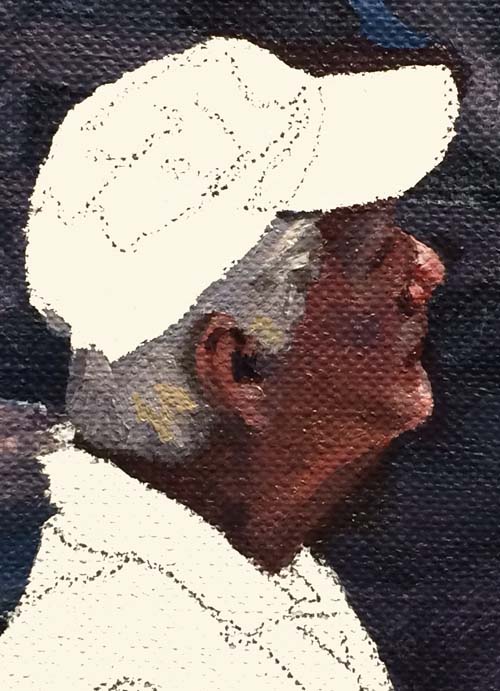
Painting Jay, the farmer, is next. I've begun on his face with
flesh tones. You can see the texture in the canvas because his
face is only about an inch high.
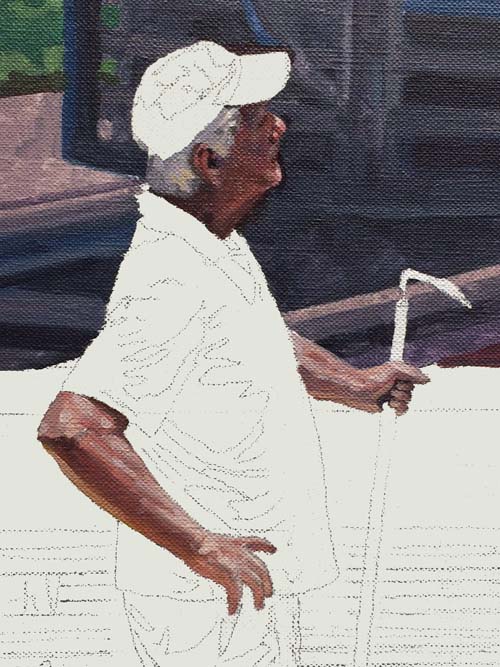
While I had some flesh tones mixed, consisting of alizaron
crimson, burnt umber, untramarine blue, cadmium red and yellow
and white, I applied some broad coverage to his arms, saving
some detail work when I apply the thicker coat of oil pigment.
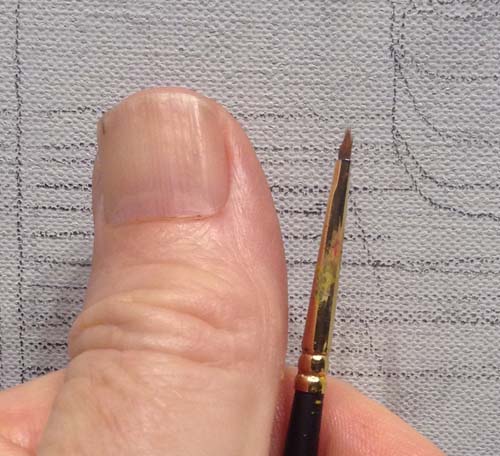
Just to give an idea of what size a 00 brush is, this photo of
the sable brush next to my thumb tells the story.
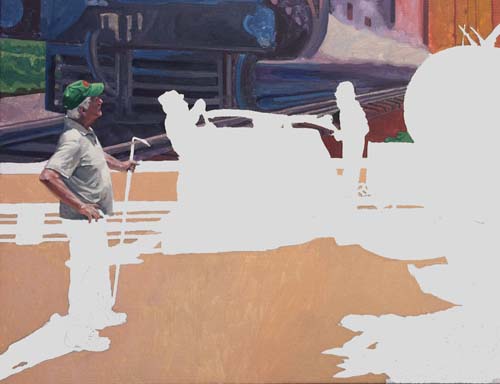
As I moved down onto the shirt of the farmer, I realized that if
I painted the light struck areas of the ground, I would be able
to determine better what values (darkness) I should paint his
trousers.

With a mixture of French ultramarine blue, thalo blue, a little
burnt sienna and white, I applied the blue color of his jeans. I
exaggerated some of the
reflective shadow areas with some cadmium yellow and cadmium
red.
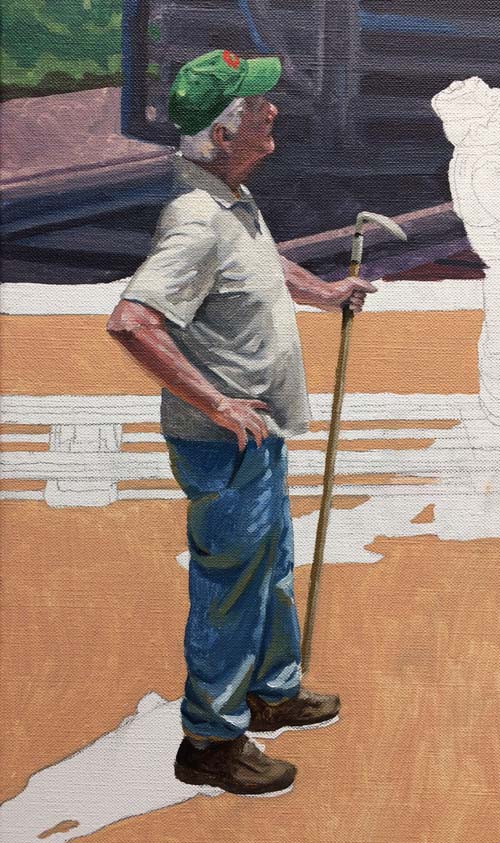
I changed his tennis shoes to some brown work shoes.
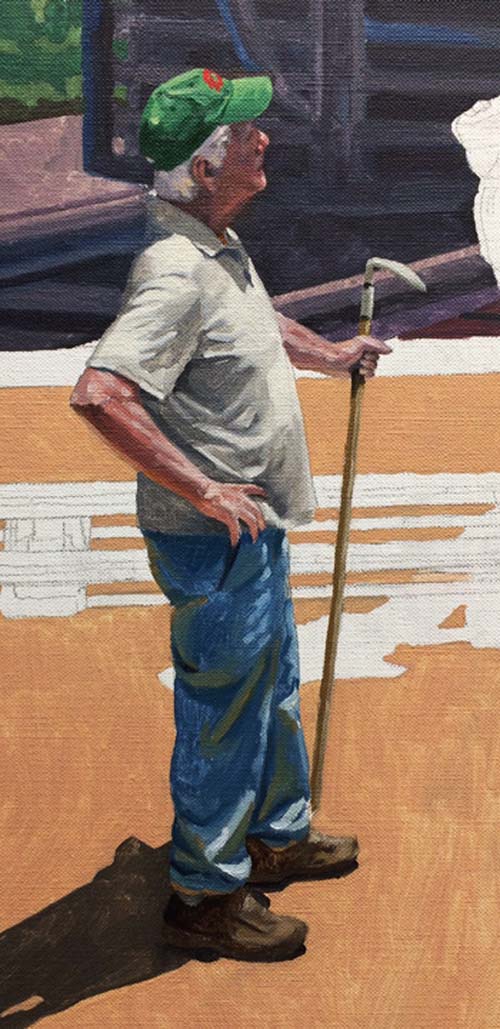
With his cast shadow painted in, he sets the tone for the cast
shadows of all the other objects.
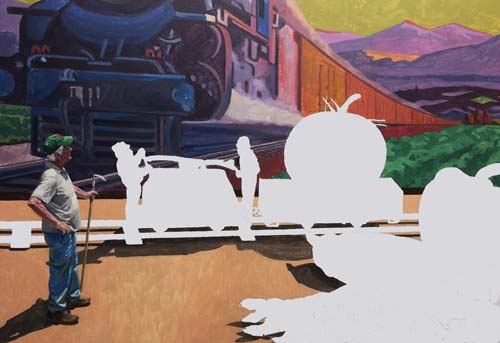
Here's a look at the lower part of the painting with all the
foreground surface and shadows painted in. Notice that the
shadows are darker under objects that block the light.
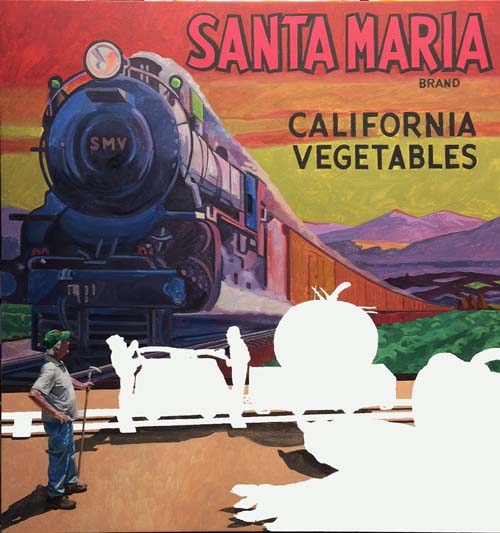
This photo shows the entire canvas. I'll move on to the toy hand
car next.
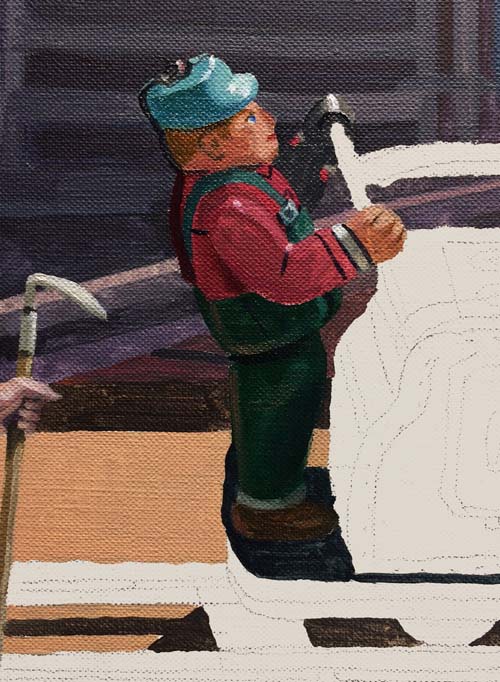
I'll begin at the left of the hand car and work my way to the
right. When painting small detail, I have to rest one or both of
my hands on the canvas, and working from left to right gives me
the space to touch the surface.
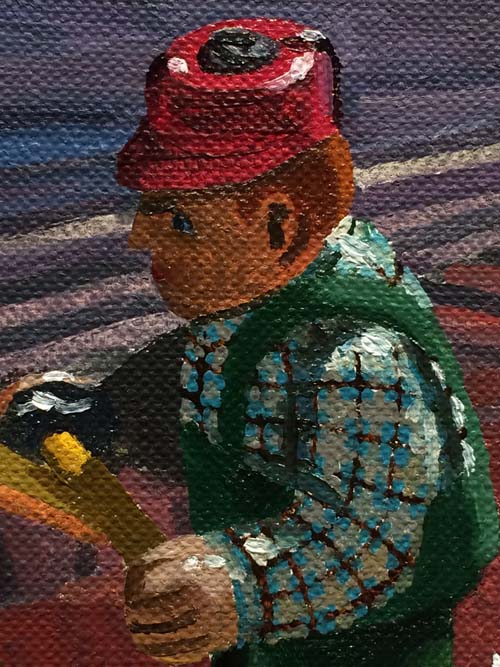
Here's a detail of the tin man on the right side of the hand
car. Although I am working with thinned oil pigment, as I get to
the highlights, I thicken the paint to get some light to bounce
off of it.
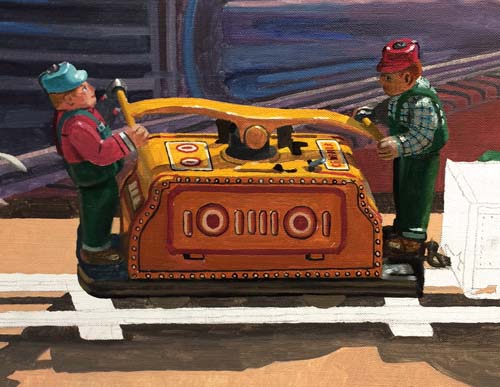
The first coat of paint is finished on the hand car. A lot of
time dedicated to getting the drawing correct. I worked with my
00 (double ought) brushes, both bright and round.
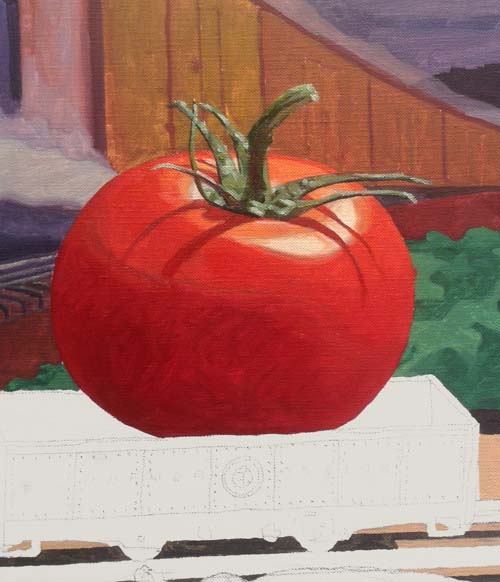
The tomato in the hopper car. Looking at it now, I can tell I
will have to increase the value in the shadow area of the
tomato. It needs more contrast.
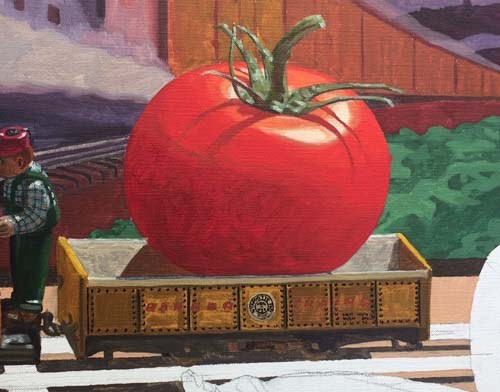
The hopper car has lots of tiny rivets painted on it. I'm
putting them in larger in this paint passage and will 'trim'
them up with the next layer of paint.
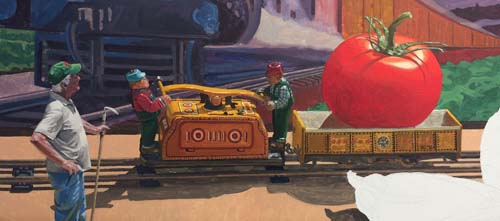
I just rendered the toy train track from the left side of the
canvas to the far right side.
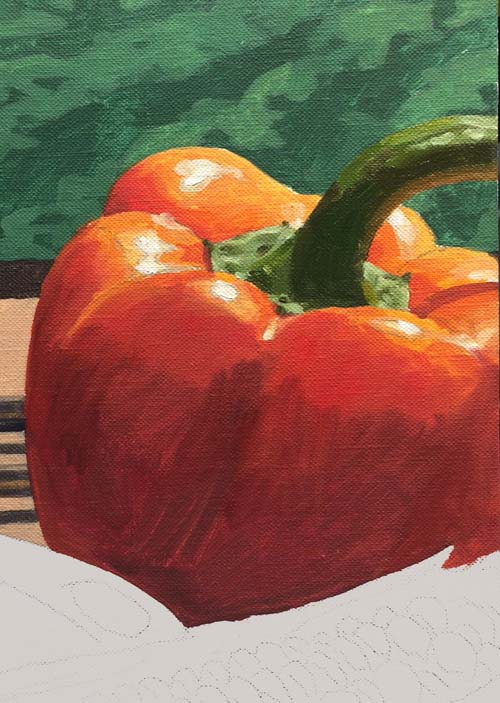
The orange bell pepper helps to balance out all the greenery
behind it.
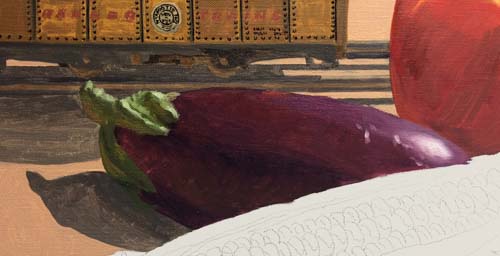
I don't recall if I've ever painted an eggplant. The purple
color really adds to the collection of veggies.
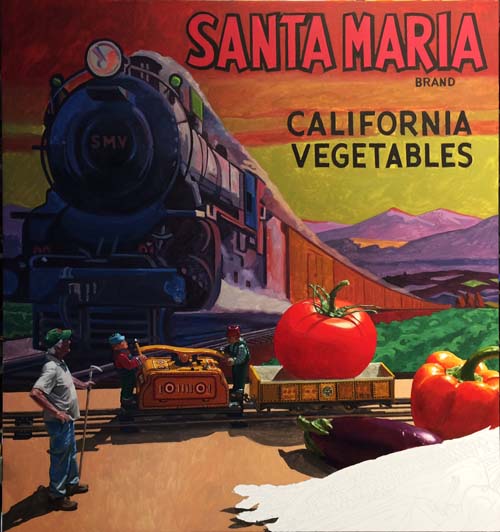
Take a look at the overall painting. Time to tackle all the
kernels of corn!
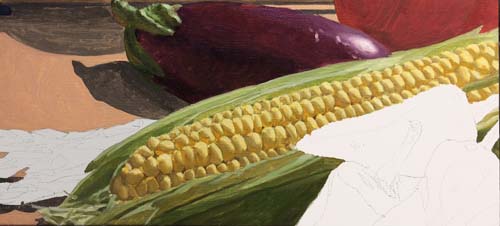
The kernels of corn were a little on the white side (could have
been white corn), so I decided to 'yellow them up'. It's
important in my paintings to be literal with my rendering on
objects that are in the foreground. Since I'm trying to convince
the viewer that what they are looking at is real, painting
objects loosely in the foreground wouldn't help me convince my
audience.
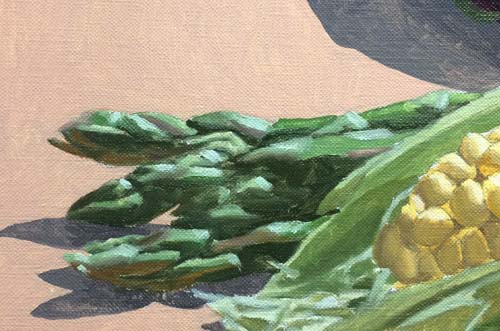
The asparagus are peeking out from behind the ear of corn. Their
tips are reflecting the warmer hue of the ground they are
sitting on.

Lastly, I've painted in the deep reds of the peppers. They were
a little on the cooler side of red, so I used more alizaron
crimson than cadmium red in the mix.
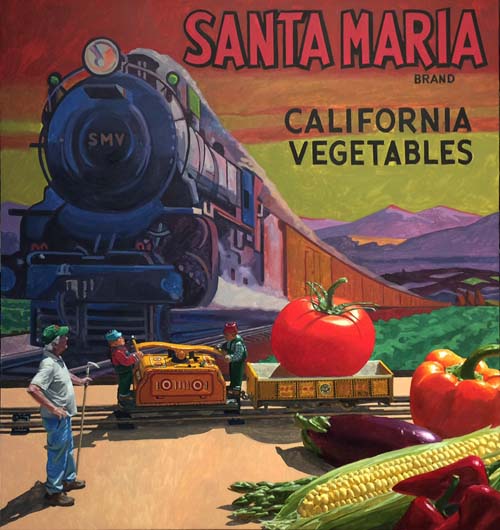
This halfway photo gives some idea what the image will look like
when it is finished. The background will be getting considerably
darker to help make the foreground light up. Time to evaluate
all areas of the painting and make some mental notes on what
areas and objects to correct.
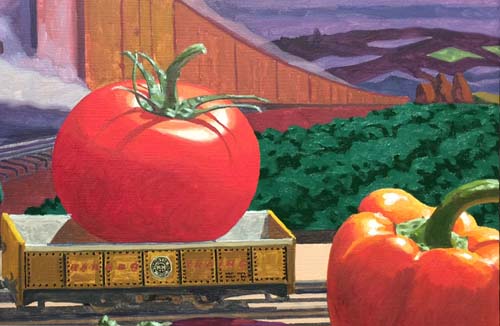
To start off the final layer of paint, I've chosen to begin with
the green agricultural crop on the background crate label. By
darkening it first, it allows me to get an idea of (1) How its
value will make the bell pepper light up and (2) Give me
something to relate to in the rest of the background so that I
can begin to determine what areas need to be darkened.
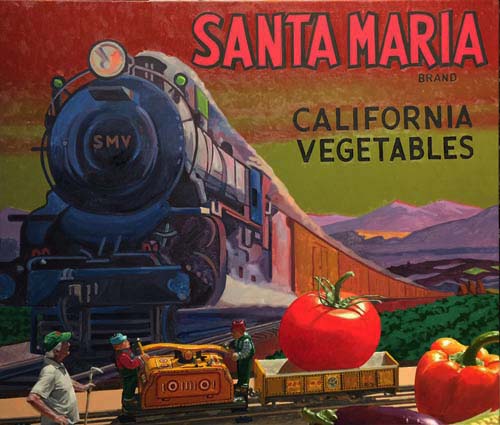
I've just finished darkening the sky of the crate label. You can
see how it makes the 'Santa Maria' lettering pop out, telling me
that those two words will be darkened later. The mountains are
now lighter than the sky, where they were darker looking with
the first passage of paint. This darkening of the sky will allow
me to really put some contrast in the background. I'll be
darkening the train so that, in contrast, it will lighten the
sky.
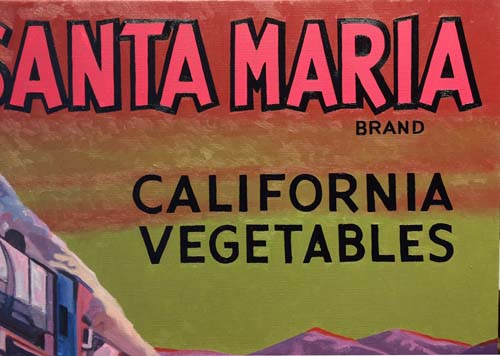
The black outline on 'SANTA MARIA' and the 'CALIFORNIA
VEGETABLES' takes some knowledge of letterforms and a steady
hand. You can see how the dark outline makes the 'SANTA MARIA'
pop out, telling me that I need to darken the red color when I
give it the final layer of paint.
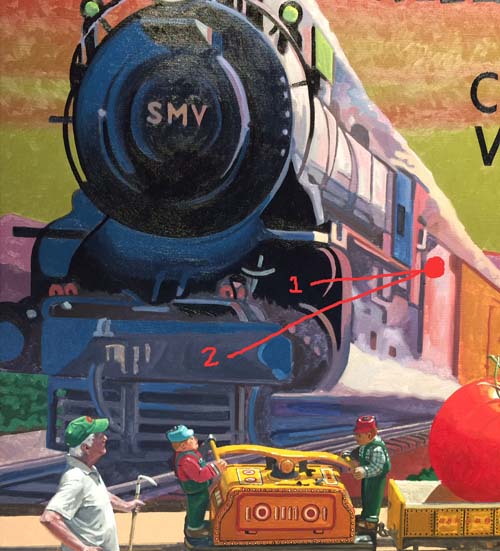
I've determined that some areas of the background train need to
be as dark as possible. You can see the difference between the
first application of paint (#2) and the final dark layer (#1).
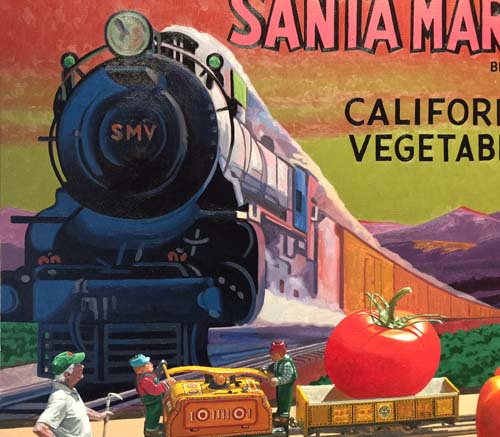
This photo shows the front of the train completed with all the
increased values. Notice how light the side of the train looks
in comparison.
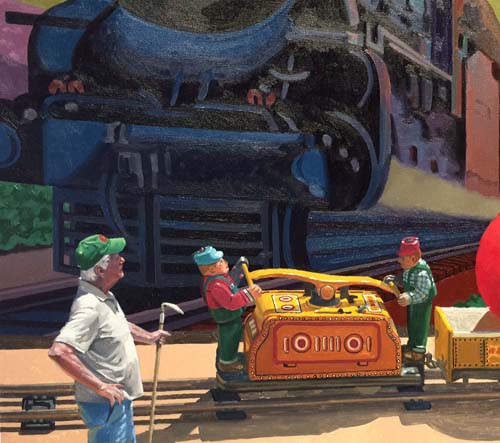
I've moved down below the train onto the track (in the back wall
crate label) and darkened all the other areas around the train.
You can get a better idea, now, how the darker values of the
background make the light struck foreground areas really glow.
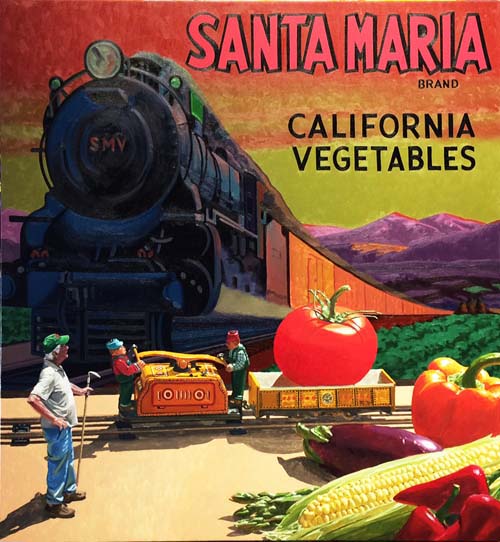
This full canvas photo shows (even though I haven't painted the
darker values on the boxcars), how the foreground objects not
only start visually separating themselves from the background,
but it also helps me see that I must darken a lot of foreground
areas to get that 3-D feeling that strong contrast helps to
portray.
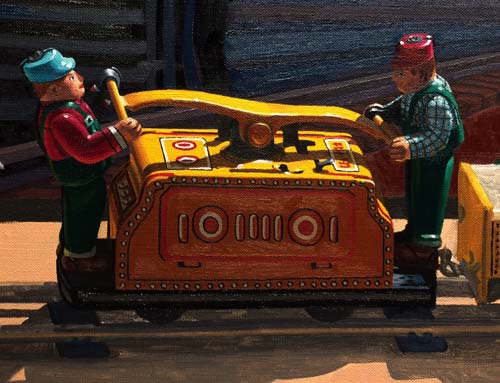
The inspiration for this painting, the handcar, has its final
layer of paint. After I paint the tomato and the hopper car,
I'll do the train tracks and shadows, solidifying the handcar's
visual connection to the track.
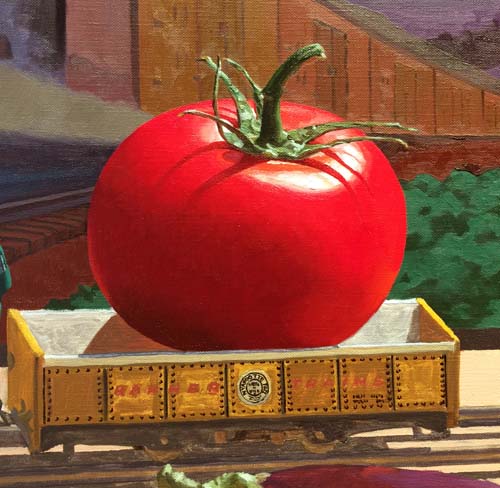
I rendered the tomato, keeping in mind all the reflective areas
in the shaded areas of the veggie. You can see a sliver of
lighter, warmer color on the left edge and a warmer lightened
area in the shaded area of the lower front of the tomato. Some
of the reflected light on the front lower area is from the
orange bell pepper, while the sliver on the left area is from
the light bouncing off the inside of the hopper car.
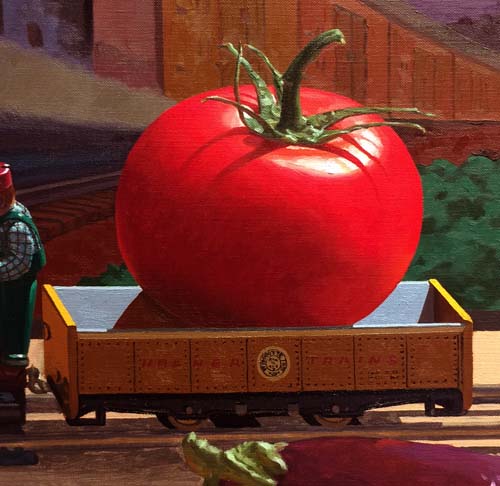
Well, I've been away from the easel for awhile, handling all the
day to day activities that the Festival of Arts entails. The
show has ended and I'm back in the studio. I've just fininished
the final layer of paint on the railroad hopper car. Lots of
small detail.
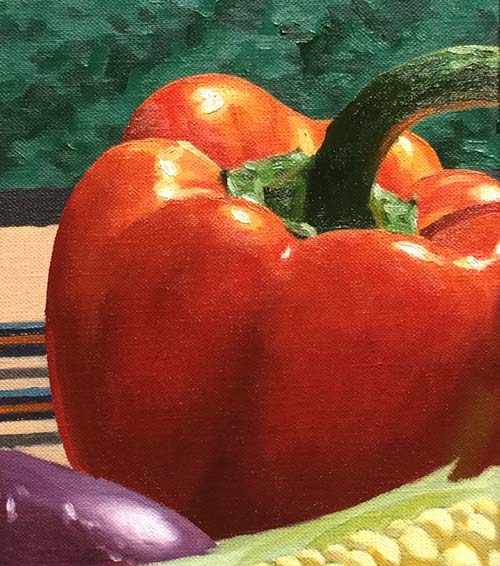
Moving down the canvas, I've finished painting the bell pepper,
warming it up to separate it from the cooler red of the tomato.
I also painted the railroad track, reflecting some of the
peppers warm orange into the rails.
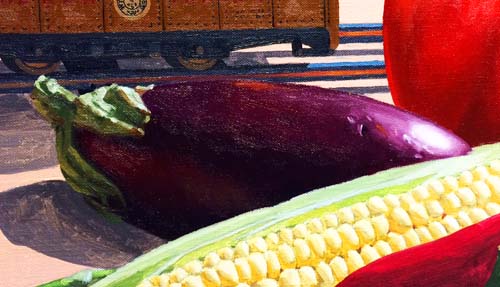
The eggplant was next. I've added some rich red tones in the
purple skin to put some life into it.
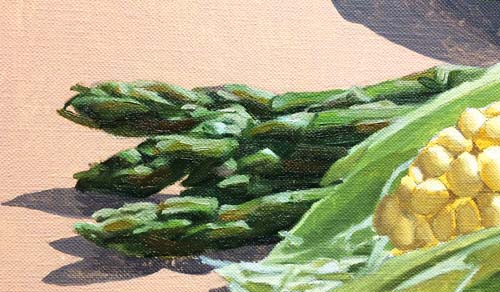
The asparagas has a variety of green hues, warm and cool.

I've rendered every kernel on this ear of corn, along with the
silk that covers the top of the husk.
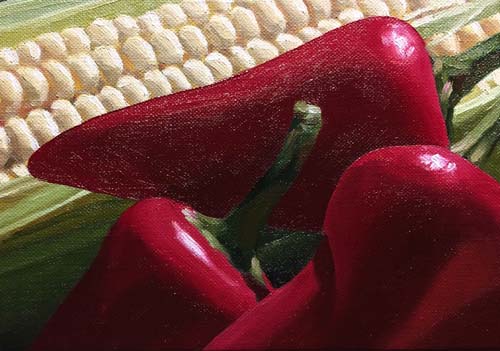
The peppers are the last of the peripheral items to be painted.
I'm ready to spend a few days finishing the farmer.
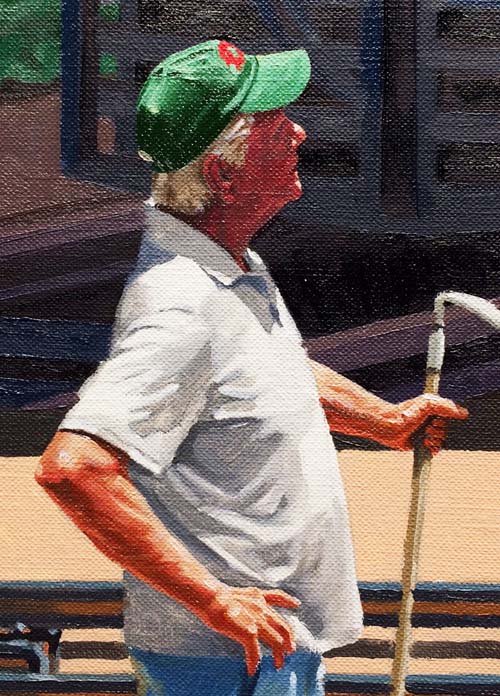
I have warmed up the flesh tones on the farmer, giving him more
'life'. Although I haven't finished his shirt or hoe, you can
see the difference by comparing this earlier photo below.
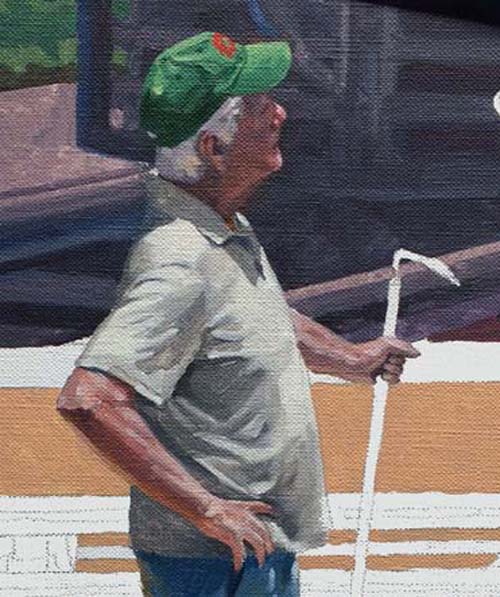
This is the earlier photo of the farmer's flesh tones when they
were painted much 'cooler' in hue.
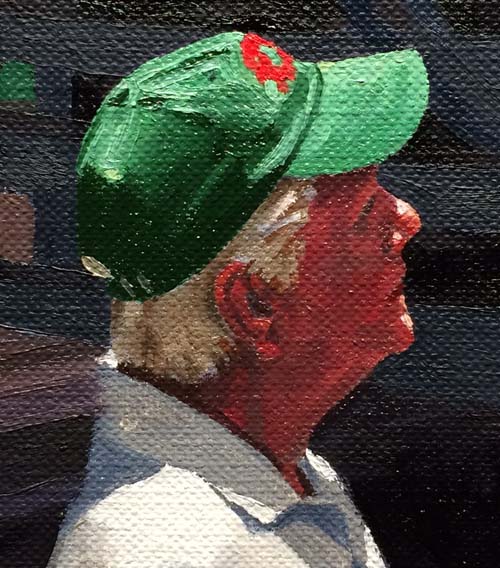
This close-up gives you some idea of the varying tones
within the parameters of the face and a look at the final
strokes of paint on the hat.
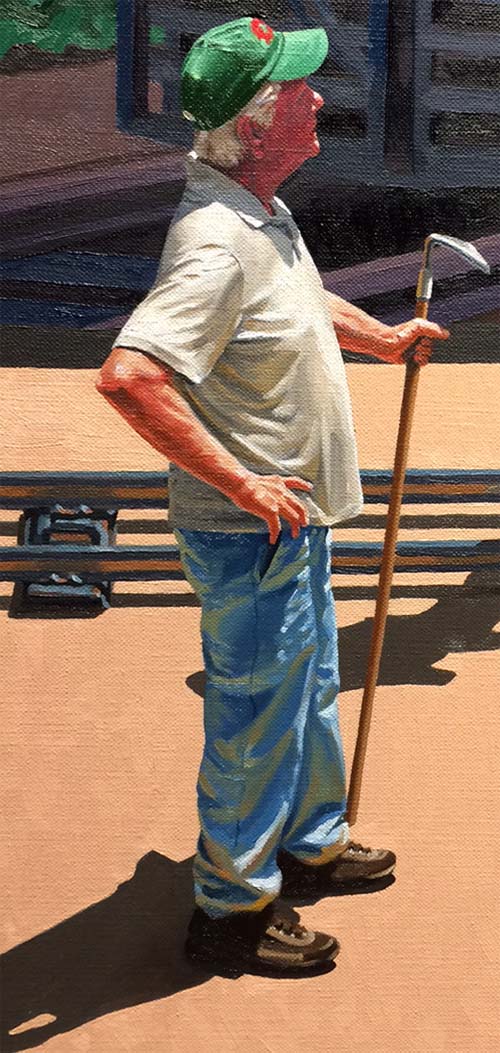
This full shot of the farmer (Jay) shows the finished layer of
pigment. Notice the warm reflective shadow areas in both his
shirt and pants.
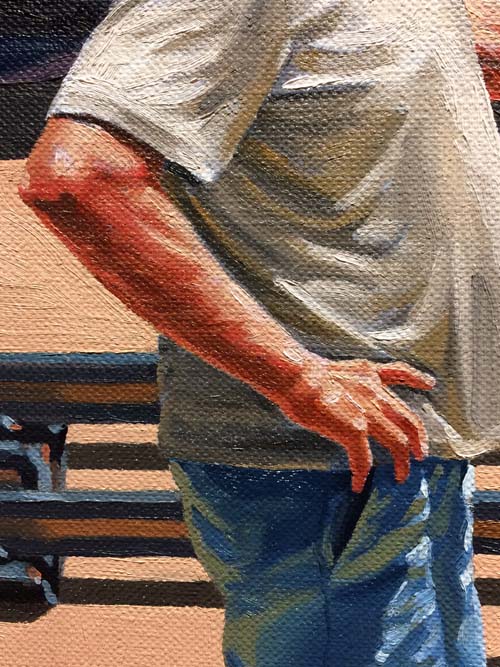
Here are a few detail photos to give you not only the detail
work, but to show the texture of the canvas and the thickness of
the brushstrokes of the final paint application.
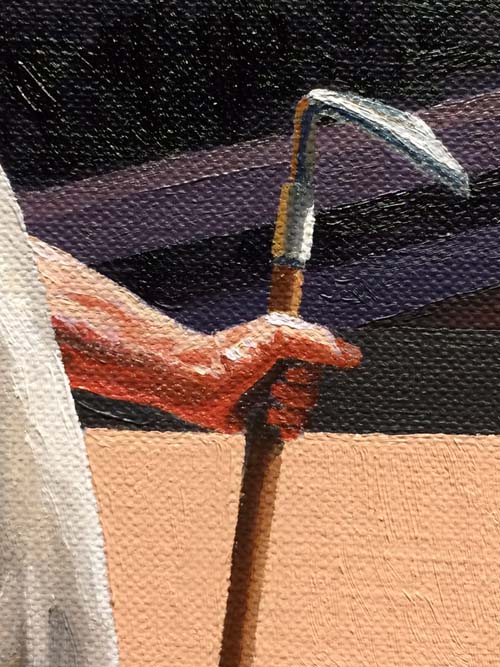
Close-up of his left hand.

I've painted the ground and the cast shadows.
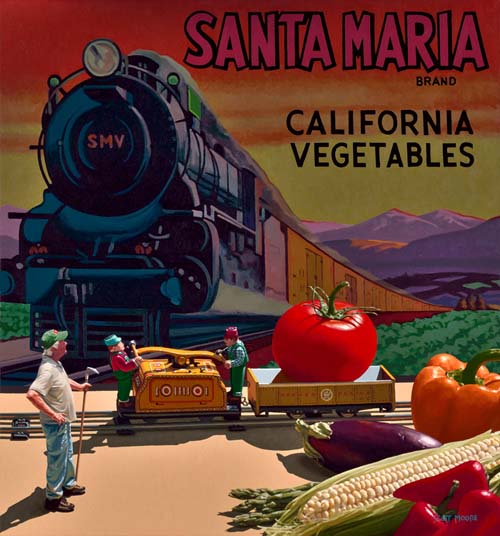
"California Vegetables" is finished. I'll replace this photo
with a final one, once I apply a light coat of varnish which
will bring out all the dark areas that have dried lighter.
|